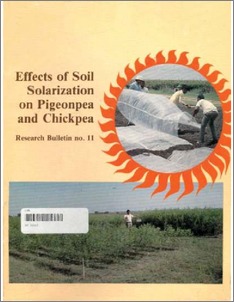Effects of Soil Solarization on Pigeonpea and Chickpea. Information Bulletin No.11
Abstract
The experience gained with field tests on the effects of soil solarization on pigeonpea(Cajanus cajan (L.) Millsp.)and chickpea (Cicer arietinum L.) crops through a multidisciplinary team effort, at ICRISAT Center during 1984-87, is highlighted. The studies were conducted in fields infested wi th fusarium wilt. Solarization was done by covering the soil with transparent polythene sheeting(100μm thick)for 6-8 weeks during summer(Apri l/May). This increased soil temperatures by 6-10°C in the 0-20-cm soil profile. Other changes recorded were increased mineralization of soil nitrogen to nitrate, a decline in populations of fusarium propagules and plant parasitic nematodes, and decreased weed infestation. When the crops were grown, effective control of fusarium wilt disease in the susceptible genotypes of pigeonpea and chickpea was observed along with improved plant growth and yield. Nodulation and N-fixation were adversely affected because of the decline in Rhizobium population with solarization. However, plant growth and yield were not adversely affected probably because of the compensatory effect of increased soil nitrate. Even in wilt-resistant genotypes of both crops, particularly of pigeonpea, there was a significant increase in yield indicating beneficial effects of solarization other than disease control. There was a considerable residual effect of solarization in the second and third seasons on yield of chickpea, but not of pigeonpea. Different techniques and methods employed in applying solarization and in assessing its impact are described. The implications of utilizing solarization for these and other crops are discussed

